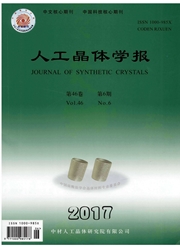

 中文摘要:
中文摘要:
研究了顺磁性Al-4.5Cu合金添加Al-5Ti-1B细化剂后,在强磁场下定向凝固时凝固组织中织构的形成规律和晶界特征分布.结果表明:当温度梯度为27 K/cm,未施加磁场时,细化后晶粒取向杂乱;施加磁场后,随着磁场强度的提高,晶粒位向发生变化,晶粒沿a-Al易磁化轴〈310〉发生取向排布.伴随〈310〉织构的生成,晶粒中重位点阵(CSL)晶界比例提高.熔体中具有磁晶各向异性的a-Al晶粒在磁场下受磁转矩作用发生转动,是织构生成的主要原因.还讨论了磁场下流体流动对织构生成和晶界的影响.
 英文摘要:
英文摘要:
ABSTRACT Directional solidification of A1-4.5Cu alloy refined by adding A1-5Ti-1B has been carried out to in- vestigate the texture formation and grain boundary characteristic of the paramagnetic crystal under a high magnetic field. OM and EBSD were applied to analyze the microstructures solidified at different temperature gradients (G) and magnetic field intensities (B). The results show that at the temperature gradient of 27 K/cm, the orientations of fec α-A1 grains without magnetic field are random. However, as a high magnetic field is imposed, the easy magneti- zation axes (310) of the α-A1 grains are aligned parallel to the direction of the magnetic field leading to (310) tex- ture. Meanwhile, the ratio of coincidence site lattice (CSL) grain boundaries increases with the increment of mag- netic field intensity and reaches its maximum value at 4 T, but decreases as the magnetic field enhances further. On the other hand, when the temperature gradient is elevated, columnar dendrite morphology is exhibited without mag- netic field; while a 6 T high magnetic field is introduced, the columnar dendrites are broken and equiaxed grains of random orientations are obtained. The alignment behavior of the free crystals in melt could be attributed to the mag- netic crystalline anisotropy of a-A1. Moreover, the influence of fluid flow on the texture formation and CSL grain boundary development under magnetic field is discussed. The absence of convection is benefit for grain reorienta- tion and CSL boundary formation. The application of high static magnetic field will inhibit the macro-scale convec- tion. However, the interaction between thermoelectric current and magnetic field will cause micro-scale fluid flow, i.e., thermoelectric magnetic convection (TEMC). The TEMC will give rise to perturbation near the solid-liquid in- terface leading to the appearance of freckles as well as the decreasing of the ratio of CSL boundary. Moreover, it is proposed that the formation of CSL boundary is associate
 同期刊论文项目
同期刊论文项目
 同项目期刊论文
同项目期刊论文
 期刊信息
期刊信息
